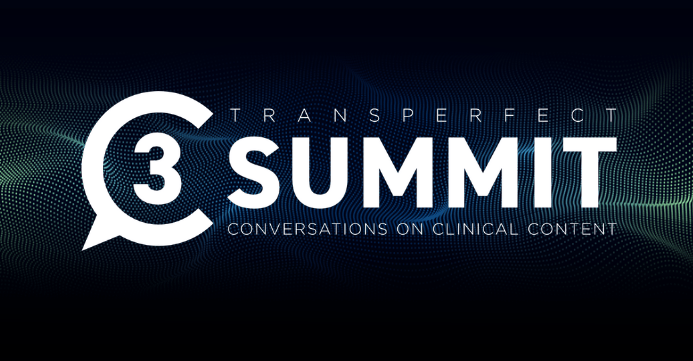

By Darcy Grabenstein
This year’s C3 Summit, Conversations on Clinical Content, drew a sizeable crowd to Princeton, NJ, on Oct. 19. The summit, hosted by TransPerfect Life Sciences, lived up to its hype, as pharma, biotech, CRO, and regulatory thought leaders discussed challenges, opportunities, and strategies through the lens of real-world experience. Citeline Connect recruitment partners ― including CliniSpan Health and 1nHealth ― were part of the expert panels.
Sessions ranged from “Inspection War Stories” to clinical trial diversity and artificial intelligence (AI)/machine learning (ML). Reporting from the front lines of regulatory inspections, Beigene’s Jamie Marie Toth, Global Head of TMF Management & Records, noted that the US Food & Drug Administration (FDA) has been tagging along to European Medicines Agency (EMA) inspections.
Both Gillian Gittens, Director of eClinical Strategy & Solutions, Trial Interactive for TransPerfect Life Sciences, and Laura Naranjo, Global Head, TMF Operations and Records Management for Daiichi Sankyo, Inc., offered practical advice to those dealing with inspections. In terms of an inspection arsenal, Gittens said study sponsors should focus on everything from related documents to processes and strongly recommended they hold mock inspections. Naranjo said it is important for sponsors to have processes in place so they are prepared for an inspection at any time. “Don’t freak out when an inspection occurs,” she cautioned.
My colleague Ryan Bell, Marketing Director, Patient Recruitment & Engagement, and I were interested in the session, “Patient Recruitment and Inclusivity – Engagement Strategies for Diversity and Accessibility,” as it relates to our priorities at Citeline. “Cultural competency is super important” when promoting clinical trial diversity, said Dezbee McDaniel, Cofounder/CEO of CliniSpan Health.
Trust, or the lack thereof, is a key consideration among those traditionally underrepresented in clinical trials. However, a distinction was made between cognitive trust and affective trust. Cognitive trust is based on information, such as confidence in a physician’s skills, accomplishments, and reliability. Affective trust is based on feeling. “I trust that you actually care about me,” McDaniel explained.
While in theory the FDA diversity guidance requiring a diversity plan for all Phase III trials is a step in the right direction, panelists saw it as a first step. Del Smith, PhD, CEO/Co-founder of Acclinate, attributes the lack of diversity in trials to systemic issues. “There are headwinds that we’re working against,” he said. Because there are no systemic tailwinds to bolster diversity efforts, additional time and resources are needed to make progress.
Rick Ward, SVP North America for CluePoints, offered a different perspective on connecting with marginalized groups: “Rather than thinking of targeting groups, think of engaging groups.”
Steve Wimmer, Vice President of Partnerships for 1nHealth, said that in order to communicate effectively with people in these demographics, sponsors must use the language, culture, and ethos of those groups.
The next session was not as daunting as its title: “Real-World Examples of AI/ML Automated Risk Reduction – Patient Safety, Regulatory Submissions, and Clinical Document Quality.” Panelists debated the pros and cons of AI.
AI is in its early stages, said Richie Etwaru, Chairman & Chief Creative Officer of Mobeus. The turning point will be when it goes from being a toy to being a tool. When a breakthrough happens in a particular science, culture sees it as the new speed of light, which is not sustainable. “It’s going to slow down, and it’s going to get institutional,” he said. “We’re not going to go at 800 miles per hour.”
Etwaru dismissed concerns over AI and intellectual property. “I would argue that 90 percent of what companies consider is proprietary data is not. They might as well just give it out and get ahead of the game.”
Touching on the recurring theme of trust, Etwaru acknowledged there is still a lot of mistrust around AI. “There is commercial incentive,” he said, “to make AI trustworthy.”
The afternoon ended with a forward-looking session: “2023 and Beyond – Sticky Innovations and Approaches from Recent Years That Are Here to Stay (and Predictions for What Comes Next).” Panel moderator Jay Smith, Head of Product, Trial Interactive, TransPerfect, kicked off the session by asking for a show of hands from those who felt the following innovations were sticky:
- cloud platforms
- adaptive trial designs
- remote patient monitoring (RPM)
- digital biomarkers
- machine learning
- patient-centric approaches
- eConsent
- eSource
- blockchain
Smith noted that some of the innovations mentioned above seemed very promising initially but did not take off. “I’ve always been surprised at how long it takes for stuff to stick,” he commented. The panelists discussed the importance of sharing evidence, the use of AI in clinical trial execution, and more.
Echoing a theme that ran through the day’s presentations, the discussion circled back to trust, emphasizing that trust is built on transparency.





